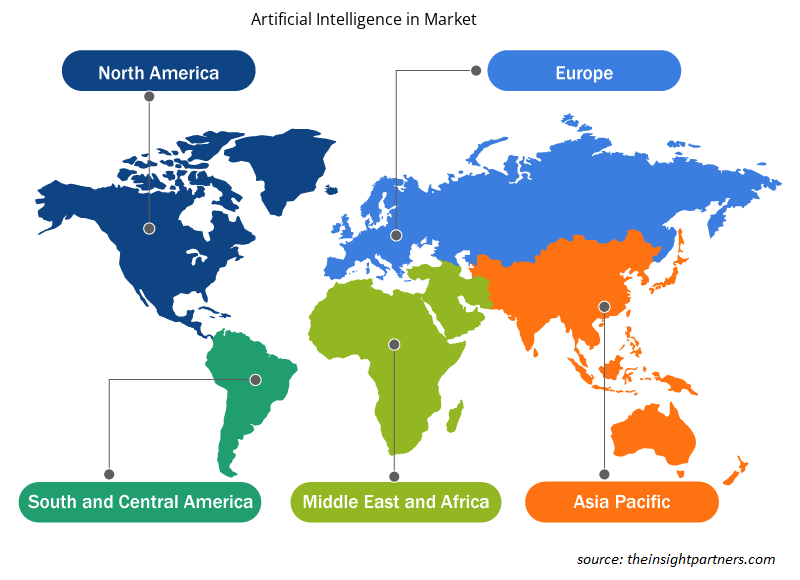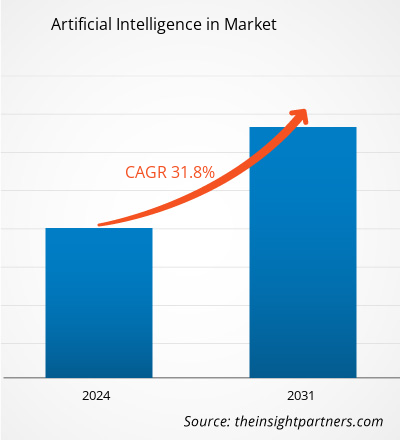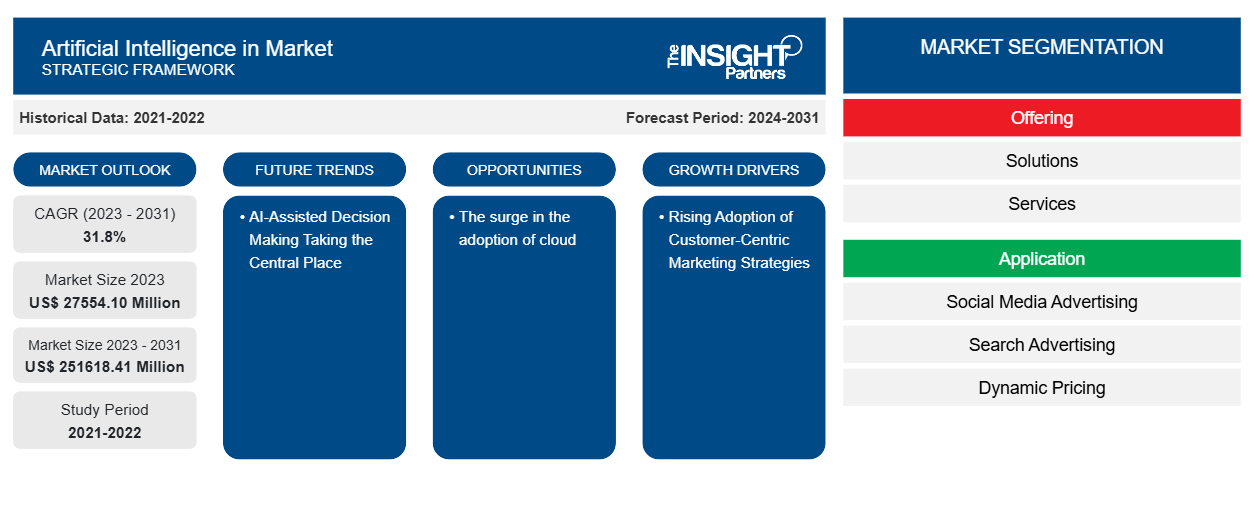Le marché de l'intelligence artificielle dans le marketing devrait atteindre 251 618,41 millions de dollars américains d'ici 2031, contre 27 554,10 millions de dollars américains en 2023. Le marché devrait enregistrer un TCAC de 31,8 % au cours de la période 2023-2031. La prise de décision assistée par l'IA, qui occupe une place centrale, devrait rester une tendance clé du marché.
L'intelligence artificielle dans l'analyse du marché du marketing
L’utilisation croissante des plateformes de médias sociaux pour la publicité et l’adoption croissante de stratégies marketing centrées sur le client font partie des facteurs qui stimulent la croissance de l’intelligence artificielle dans le marché du marketing. Cependant, la pénurie de personnel maîtrisant bien l’IA freine la croissance du marché. En outre, l’essor de l’adoption d’ applications et de services basés sur le cloud crée des opportunités notables pour les acteurs du marché de l’intelligence artificielle dans le marketing.
Aperçu du marché de l'intelligence artificielle dans le marketing
Les technologies d’intelligence artificielle (IA) sont utilisées dans le marketing pour aider à la prise de décision automatisée basée sur la collecte de données, l’analyse et les observations d’audience supplémentaire ou de tendances économiques qui pourraient affecter les campagnes marketing. L’IA est fréquemment utilisée dans les campagnes de marketing numérique lorsque l’efficacité est cruciale. Lorsque la rapidité est cruciale dans les efforts de marketing numérique, l’IA générative est fréquemment utilisée. Les solutions de marketing IA apprennent à interagir le plus efficacement possible avec les clients en utilisant les données et les profils des clients. Elles délivrent ensuite des messages personnalisés au moment opportun sans l’aide des membres de l’équipe marketing, garantissant ainsi une productivité optimale. L’IA générative est utilisée par un grand nombre de spécialistes du marketing numérique modernes pour soutenir leurs équipes ou mener des activités plus tactiques qui nécessitent moins de délicatesse humaine.
Personnalisez ce rapport en fonction de vos besoins
Vous bénéficierez d'une personnalisation gratuite de n'importe quel rapport, y compris de certaines parties de ce rapport, d'une analyse au niveau des pays, d'un pack de données Excel, ainsi que d'offres et de remises exceptionnelles pour les start-ups et les universités.
-
Obtenez les principales tendances clés du marché de ce rapport.Cet échantillon GRATUIT comprendra une analyse de données, allant des tendances du marché aux estimations et prévisions.
L'intelligence artificielle dans le marketing : moteurs et opportunités du marché
Adoption croissante de stratégies marketing centrées sur le client
Pour prospérer sur un marché mondial extrêmement concurrentiel, de nombreuses entreprises, quel que soit leur secteur d'activité, s'efforcent de nouer des relations à long terme et mutuellement bénéfiques avec leurs clients. Ces dernières années, les tactiques et les actions d'engagement client ont évolué, passant d'une approche principalement axée sur le produit à une approche davantage centrée sur le client. En adoptant une approche centrée sur le client, les entreprises peuvent anticiper et mieux répondre aux besoins de leurs clients à tout moment. Il a été démontré que les entreprises qui ont efficacement adopté une approche centrée sur le client ont un avantage concurrentiel significatif ainsi qu'une augmentation des ventes et des revenus. Selon la Harvard Business Review, plus d'un tiers des entreprises du Fortune 500 ont restructuré leur activité en pensant au client, en utilisant les parcours, les préférences et la segmentation comme principes directeurs. Cependant, de nombreuses entreprises bien connues ont adopté avec succès une approche centrée sur le client ces dernières années. Les entreprises les plus populaires axées sur le client aux États-Unis comprennent USAA, Tumi et American Express. Des compagnies aériennes comme Singapore Airlines, Air Innovative Zealand et Emirates abandonnent leurs méthodes traditionnelles au profit de formes de publicité innovantes.
L'essor de l'adoption du cloud
Pour les utilisateurs du Cloud, l'intelligence artificielle (IA) est devenue un outil multifonctionnel pour la gestion des données, la sécurité, l'analyse des données et la prise de décision stratégique. Sa capacité à utiliser l'apprentissage automatique et à produire des interprétations objectives des informations basées sur les données augmente l'efficacité de ces procédures et permet à l'entreprise d'économiser une somme d'argent substantielle. L'utilisation de logiciels d'IA basés sur des algorithmes d'apprentissage automatique dans des environnements cloud permet aux entreprises de fournir aux utilisateurs et aux consommateurs des expériences connectées et conviviales. Par conséquent, l'essor de l'adoption du cloud crée diverses opportunités pour le marché.
Analyse de segmentation du rapport sur le marché de l'intelligence artificielle dans le marketing
Les segments clés qui ont contribué à la dérivation de l’intelligence artificielle dans l’analyse du marché du marketing sont l’offre, l’application et l’industrie d’utilisation finale.
- En fonction de l'offre, l'intelligence artificielle sur le marché du marketing est divisée en solutions et services. Le segment des solutions détenait une part de marché plus importante en 2023.
- En termes d'application, le marché est segmenté en publicité sur les réseaux sociaux, publicité par moteur de recherche, tarification dynamique, assistant virtuel, curation de contenu, automatisation des ventes et du marketing, plateforme d'analyse, etc. Le segment de la publicité sur les réseaux sociaux détenait une part de marché plus importante en 2023.
En fonction de l'industrie d'utilisation finale, le marché est segmenté en BFSI, vente au détail, biens de consommation, médias et divertissement, et autres.
Analyse des parts de marché de l'intelligence artificielle dans le marketing par zone géographique
La portée géographique du rapport sur le marché de l'intelligence artificielle dans le marketing est principalement divisée en cinq régions : Amérique du Nord, Asie-Pacifique, Europe, Moyen-Orient et Afrique, et Amérique du Sud et centrale.
L'Amérique du Nord domine le marché de l'intelligence artificielle dans le marketing. Les principaux acteurs du marché de l'intelligence artificielle dans le marketing, tels qu'Adobe, Amazon Web Services, IBM, Salesforce et Accenture, ont adopté diverses stratégies organiques et inorganiques pour améliorer leurs revenus et leur positionnement sur le marché. Par exemple, Appier a lancé ARTIFICIAL INTELLIGENCEXPERT, un assistant publicitaire basé sur une application alimenté par l'INTELLIGENCE ARTIFICIELLE qui aide les spécialistes du marketing à faire évoluer facilement les performances de leurs campagnes de vente grâce à l'intelligence artificielle. Ainsi, le marché est en croissance dans la région.
Portée du rapport sur le marché de l'intelligence artificielle dans le marketing
L'intelligence artificielle dans les marchés régionaux
Les tendances et facteurs régionaux influençant l'intelligence artificielle sur le marché tout au long de la période de prévision ont été expliqués en détail par les analystes d'Insight Partners. Cette section traite également des segments de marché et de la géographie de l'intelligence artificielle en Amérique du Nord, en Europe, en Asie-Pacifique, au Moyen-Orient et en Afrique, ainsi qu'en Amérique du Sud et en Amérique centrale.

- Obtenez les données régionales spécifiques à l'intelligence artificielle sur le marché
Intelligence artificielle dans le champ d'application du rapport de marché
| Attribut de rapport | Détails |
|---|---|
| Taille du marché en 2023 | 27 554,10 millions de dollars américains |
| Taille du marché d'ici 2031 | 251 618,41 millions de dollars américains |
| Taux de croissance annuel composé mondial (2023-2031) | 31,8% |
| Données historiques | 2021-2022 |
| Période de prévision | 2024-2031 |
| Segments couverts |
En offrant
|
| Régions et pays couverts |
Amérique du Nord
|
| Leaders du marché et profils d'entreprises clés |
|
L'intelligence artificielle dans la densité des acteurs du marché : comprendre son impact sur la dynamique des entreprises
Le marché de l'intelligence artificielle sur le marché connaît une croissance rapide, tirée par la demande croissante des utilisateurs finaux en raison de facteurs tels que l'évolution des préférences des consommateurs, les avancées technologiques et une plus grande sensibilisation aux avantages du produit. À mesure que la demande augmente, les entreprises élargissent leurs offres, innovent pour répondre aux besoins des consommateurs et capitalisent sur les tendances émergentes, ce qui alimente davantage la croissance du marché.
La densité des acteurs du marché fait référence à la répartition des entreprises ou des sociétés opérant sur un marché ou un secteur particulier. Elle indique le nombre de concurrents (acteurs du marché) présents sur un marché donné par rapport à sa taille ou à sa valeur marchande totale.
Les principales entreprises opérant sur le marché de l'intelligence artificielle sont :
- Affectif
- Appier Inc.
- Bidalgo
- Novantas (Amplero) Inc.
- Échelle cognitive
- Institut SAS Inc.
Avis de non-responsabilité : les sociétés répertoriées ci-dessus ne sont pas classées dans un ordre particulier.

- Obtenez un aperçu des principaux acteurs clés du marché de l'intelligence artificielle
L'intelligence artificielle dans le marketing : actualités et développements récents du marché
L'intelligence artificielle sur le marché du marketing est évaluée en collectant des données qualitatives et quantitatives après des recherches primaires et secondaires, qui comprennent des publications d'entreprise importantes, des données d'association et des bases de données. Quelques-uns des développements de l'intelligence artificielle sur le marché du marketing sont énumérés ci-dessous :
- Clarivate Plc, l'un des principaux fournisseurs mondiaux de renseignements sur la transformation, a lancé aujourd'hui la première version publique de Trademark Watch Analyzer lors de la réunion annuelle 2024 de l'International Trademark Association. En tant que solution de protection des marques de nouvelle génération améliorée par l'intelligence artificielle (IA) et la technologie cloud, cette solution combine les données mondiales de Clarivate sur les marques et la jurisprudence, l'expertise interne en propriété intellectuelle et la technologie d'IA de pointe. Elle fournira des réponses plus rapides et plus précises aux questions commerciales critiques en automatisant les tâches clés de surveillance des marques et en hiérarchisant intelligemment les ensembles de résultats. (Source : Signify, communiqué de presse, mai 2024)
- Emarsys, société spécialisée dans l'engagement client omnicanal et qui fait partie de SAP depuis 2020, a annoncé le lancement d'AI Product Finder, une nouvelle solution de recommandations de produits et d'expériences client personnalisées. Cette initiative répond à l'intérêt des consommateurs pour l'IA dans le commerce, les données d'Emarsys montrant que 64 % des consommateurs pensent que l'IA a amélioré leur expérience commerciale. (Source : Tungsram Group, communiqué de presse, avril 2024)
Rapport sur le marché de l'intelligence artificielle dans le marketing : couverture et livrables
Le rapport « Taille et prévisions du marché de l’intelligence artificielle dans le marketing (2021-2031) » fournit une analyse détaillée du marché couvrant les domaines ci-dessous :
- Taille et prévisions du marché de l'intelligence artificielle dans le marketing aux niveaux mondial, régional et national pour tous les segments de marché clés couverts par le champ d'application
- L'intelligence artificielle dans les tendances du marché du marketing, ainsi que la dynamique du marché comme les moteurs, les contraintes et les opportunités clés
- Analyse détaillée des cinq forces de PEST/Porter et SWOT
- Intelligence artificielle dans l'analyse du marché du marketing couvrant les principales tendances du marché, le cadre mondial et régional, les principaux acteurs, les réglementations et les développements récents du marché
- Analyse du paysage industriel et de la concurrence couvrant la concentration du marché, l'analyse de la carte thermique, les principaux acteurs et les développements récents du marché de l'intelligence artificielle en marketing
- Profils d'entreprise détaillés
- Analyse historique (2 ans), année de base, prévision (7 ans) avec TCAC
- Analyse PEST et SWOT
- Taille du marché Valeur / Volume - Mondial, Régional, Pays
- Industrie et paysage concurrentiel
- Ensemble de données Excel
Rapports récents
Témoignages
Raison d'acheter
- Prise de décision éclairée
- Compréhension de la dynamique du marché
- Analyse concurrentielle
- Connaissances clients
- Prévisions de marché
- Atténuation des risques
- Planification stratégique
- Justification des investissements
- Identification des marchés émergents
- Amélioration des stratégies marketing
- Amélioration de l'efficacité opérationnelle
- Alignement sur les tendances réglementaires























 Obtenez un échantillon gratuit pour - L'intelligence artificielle sur le marché du marketing
Obtenez un échantillon gratuit pour - L'intelligence artificielle sur le marché du marketing